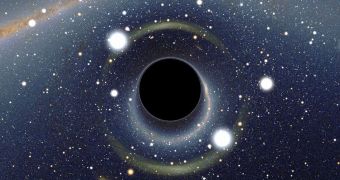Recent studies of the galactic core have revealed that a medium-sized gas cloud is rapidly heading towards Sagittarius A*, the supermassive black hole that is powering up the Milky Way. When the two collide, massive cosmic fireworks will ensue.
Studies of the feature were conducted in infrared wavelengths, because they can penetrate the thick veil of dust obscuring the galactic core from view in visible-light. The team behind the study. Led by astronomers Stefan Gillessen and Reinhard Genzel, found that it was not a star.
If the object were a star, then it should have emitted light in near-infrared wavelengths, since it would have been very bright. However, when they conducted studies at a wavelength of 2.16 microns, they could not see the object – which was perfectly visible at 3.76 microns.
This made the science group, which is based at the Max Planck Institute for Extraterrestrial Physics (MPI-EP), in Garching, Germany, conclude that it is made entirely out of gas and dust. Researchers have been monitoring the cloud for at least 9 years.
They determined that its course and speed would inevitably take it straight into Sagittarius A*. The black hole tips the scale at 4 million solar masses, and can be found at about 27,000 light-years away from the Sun. Our star takes 230 million years to complete a full orbit around the dark behemoth.
Conversely, the closest star to Sagittarius A* completes a full orbit in just 16 years. This was observed using the Very Large Telescope (VLT) the European Southern Observatory (ESO) operated at the Cerro Paranal Observatory, in Chile, ScienceNow reports.
Objectively speaking, the cloud is not that big, in the sense that it does not even have enough mass to produce a single star if subjected to the right conditions. It is only three times heavier than our planet, and spans a distance of 250 astronomical units.
An AU represents the mean distance between the Earth and the Sun, or about 93 million miles (157 million kilometers). The cloud has an average temperature of 550 degrees Kelvin (277ºCelsius or 530ºFahrenheit), which is cooler than the surface of Venus.
As it nears Sagittarius A*, it is picking up speed at a tremendous rate. Between 2004 and 2011 alone, its speed increased from 1,200 kilometers per second to 2,350 kilometers per second (745 to 1,460 miles per second). An airplane traveling at this speed would circle Earth in less than 17 seconds.
By 2013, it should collide with Sagittarius A*, and produce a large shower of radiations, in X-ray and infrared wavelengths. The event should be plainly visible to high-energy telescopes, such as NASA's Chandra and Fermi observatories.

 14 DAY TRIAL //
14 DAY TRIAL //